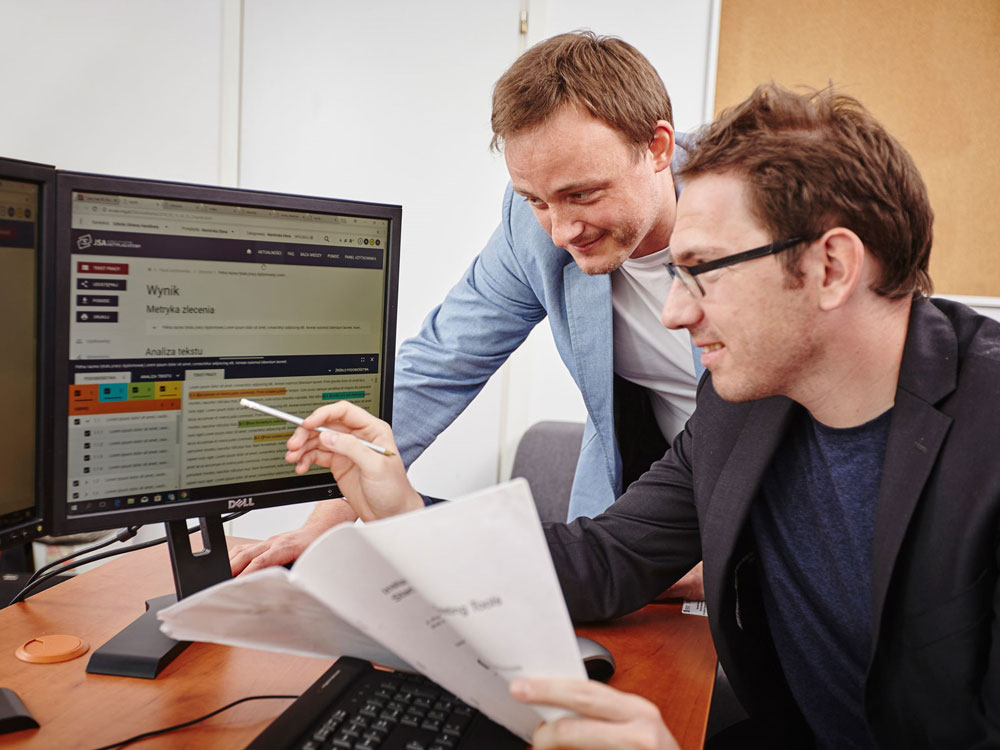Uniform Anti-Plagiarism System
Uniform Anti-Plagiarism System. Effective fight against plagiarism at universities

 Project title
Project title
Preparation of the Uniform Anti-plagiarism System, its implementation and operation
 Name of Beneficiary/Beneficiaries
Name of Beneficiary/Beneficiaries
National Information Processing Institute (OPI - PIB)
 Name of programme
Name of programme
Knowledge Education Development Operational Programme
 Competition
Competition
Non-competitive project. Measure 3.4. Management in higher education institutions
 Project value
Project value
PLN 11 000 000
 Funding value
Funding value
PLN 11 000 000
 Project delivery period
Project delivery period
1st Jul 2017 – 30th June 2019
Meet our team

Source: https://www.sztucznainteligencja.org.pl/
See also: https://opi.org.pl/laboratoria/laboratorium-inzynierii-lingwistycznej/
View the results of our work

What problem is addressed by the project?
From January 2019, Polish universities and institutes are required to check diploma theses (bachelor's, engineering, master's and doctoral dissertations) for plagiarism. They use the Uniform Antiplagiarism System (JSA), created at the National Information Processing Institute Institute in the team of Marek Kozłowski PhD. It is the only free anti-plagiarism system in Poland.
Until the creation and implementation of JSA, universities in Poland rarely used anti-plagiarism systems (in 2016, 30-40% of works were checked for plagiarism). The system was commissioned by the Ministry of Science and Higher Education.
“JSA works roughly like this: we break the text into shorter fragments: five, ten or twenty sentences, so-called bites, and then look for similarities between them and fragments of the same length that we already have in the database. There is something to compare with, because we have collected over 10 billion such microdocuments”, explains Marek Kozłowski PhD, head of the Language Engineering Laboratory at OPI - PIB. "These billions of bites come from ten large databases, incl. the National Repository of Diploma Works (over 3 million), the NEKST database (900 million documents from the Polish Internet), six language versions of Wikipedia (including Polish), databases of legal acts or currently collected OpenAccess articles. The system cannot be deceived, e.g. by changing the word order or replacing one word with another. JSA breaks down the text into individual words and creates disordered collections of elements. And only such collections are compared with source texts”.
JSA's innovation consists in:
- the scale of the system - covers the entire country (all universities, institutes in Poland, i.e. all units educating at the bachelor's, engineering, master's or doctoral level),
- the scope of data on which the system works (NEKST - the largest body of websites from Polish domains collected so far, ORPPD - the largest collection of diploma theses, OpenAccess articles, legal acts from the Polish legislative system or multilingual Wikipedia collections),
- use of artificial intelligence methods to fight plagiarism,
- conducting a two-track model of system implementation on a national scale - UI vs API (i.e. you can use JSA screens directly in the browser or use JSA indirectly through university systems integrated with JSA),
- conducting hundreds of trainings around Poland - which is an unprecedented event.
Basic information about the Unified Anti-plagiarism System is available at:
https://jsa.opi.org.pl/centrum-pomocy/o-jsa/
and in the form of graphics:
https://jsa.opi.org.pl/centrum-pomocy/wp-content/uploads/2019/09/2019-09-20_12h04_26-1.png
More information about JSA in an interview with Dr. Marek Kozłowski, with the portal biletynainteligencja.org.pl (the publisher of the portal is the National Information Processing Institute, which created and administers JSA):
https://www.sztucznainteligencja.org.pl/lowca-klonow-tropiciel-parafraz/
We also recommend:
https://www.sztucznainteligencja.org.pl/plagiat-nie-przejdzie/
https://www.sztucznainteligencja.org.pl/antyplagiator-narzedzie-nie-wyrocznia/
https://www.sztucznainteligencja.org.pl/co-cie-zdradzi-w-sieci/
Who uses the project results?
The direct users of the system are research promoters and teaching staff of all universities in Poland. Marek Kozłowski, PhD adds that the effects of the projects are in fact used by "the entire academic community, because of rising the awareness of anti-plagiarism research. Many authors withdraw from this practice in fear of detection, the knowledge about the thematic distribution of theses and the similarity between the works is also growing. "
What was the greatest challenge during project implementation?
“The biggest challenge was the scale of the undertaking. The system is used by the entire ecosystem of higher education, several hundred thousand active users. This means huge data repositories for comparison and billions of operations to verify the flow of works defended every year in Poland”- says Marek Kozłowski, PhD.